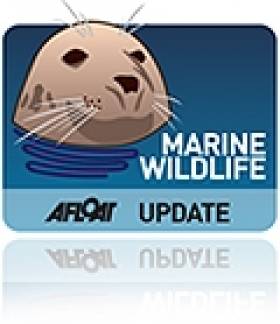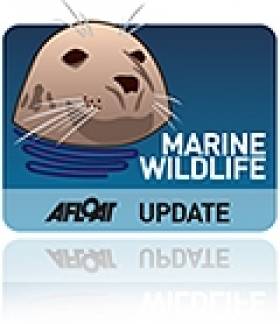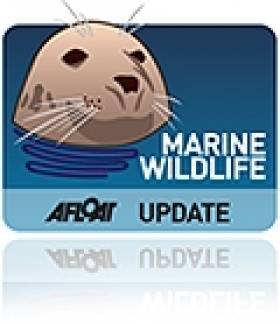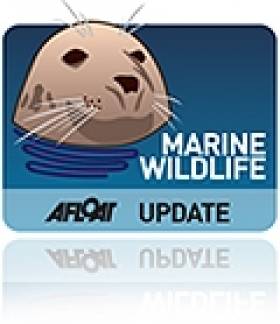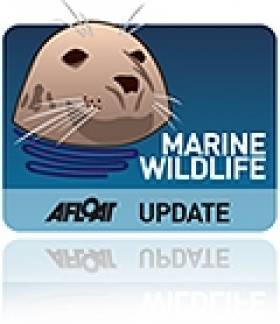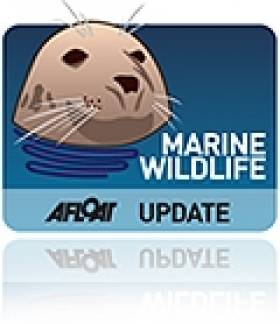Displaying items by tag: marine wildlife
Isle of Man Begins Seal Pup Survey
#MARINE WILDLIFE - The Manx Wildlife Trust has commenced its annual survey of seal pups on the Calf of Man, as Isle of Man Today reports.
Volunteers will be on watch at the island nature reserve, off the southwest coast of Man proper in the Irish Sea, for the next four weeks to develop a complete picture of the area's grey seal pupping season.
As of Sunday 14 October, some 14 seal pups have already been born, which is a few less than last year, according to marine officer Eleanor Stone - though she notes "there are still many pregnant females around, just waiting for their time to give birth".
Stone, who is volunteering on the first week-long shift, said the trust has already spotted six seals recognised from previous years, and it is expected many more will be returning to the sheltered beaches of the islet.
Isle of Man Today has more on the story HERE.
UK Conference to Uncover Secrets of the Irish Sea
#MARINE WILDLIFE - A marine wildlife conference in Cumbria aims to delve deep into the Irish Sea to uncover some of its fascinating secrets.
The Living Seas North West Conference takes place at the Netherwood Hotel in Grange-over-Sands next Friday 19 October and presents an opportunity to discover the diversity of wildlife we have in the Irish Sea – a magnet for hundreds of species from huge basking sharks to tiny molluscs and many varieties of birds.
“The Living Seas North West conference is a chance to learn more about the Irish Sea – what’s in it, what activities go on, what impacts these have had, how it was managed in the past, how it is being managed now and how can we approach its management in the future,” said Cumbria Wildlife Trust marine conservation officer Lindsay Sullivan.
World renowned ocean expert Professor Callum Roberts and explorer, naturalist and TV personality Paul Rose will be among those giving talks on the day, and there will also be discussions hosted by experts from around the UK and Ireland on topics from offshore development and fishing to coastal zone management.
And for anyone aspiring to a career in the marine or coastal environments, the afternoon careers session will introduce them to seasoned experts offering their views on how to land your dream marine job.
The Living Seas North West Conference, hosted by the Irish Sea Wildlife Trusts, runs from 9am-5pm on Friday 19 Octover. Admission is £35 per person (#15 for under-25s and students) and includes a buffet lunch, tea and coffee, and a full delegate pack. For further details visit www.irishsea.org.
Hopes for Evidence of Coral Reefs in Irish Sea
#MARINE WILDLIFE - Might there be evidence of coral reefs in the Irish Sea? Johnny Woodlock of the Irish Seal Sanctuary believes so.
Writing for Wildlife Extra, the Sea Fishery Advisory Group member recalls seeing a piece of coral that a former commercial trawler skipper said he had found in one of this nets more than 20 years ago while fishing off the Isle of Man.
Woodlock says he identified the sample as Lophelia pertusa, a coldwater coral that thrives in deeper water and one that was not previously linked to the Irish Sea, according to the records of the Marine Institute and the National Parks and Wildlife Service.
Then this past August, when Woodlock uncovered a similar piece of coral and identified it as the same species, he was able to find out the co-ordinates where both pieces had been netted and forwarded them to the Marine Institute.
Though the area of the Irish Sea in question "has been heavily trawled by larger boats pulling heavier nets for a number of years", Woodlock remains hopeful that the Marine Institute can find evidence of living coral in the depths.
Often mistaken for plant life, coral is actually a compact colony of very simple marine wildlife called polyps, encased in a skeleton of calcium carbonate which gives them their solid appearance.
Canada Watching EU Seal Cull Plans With Interest
#MARINE WILDLIFE - The Globe and Mail reports that Canada is keeping tabs on an EU plan to "manage" Europe's seal population amid growing controversy over the issue.
Last month the European Parliament approved a resolution on the Common Fisheries Policy that called for the European Commission to investigate the impact of "natural predators such as sea lions, seals and cormorants" on the reduction of fish stocks and draw up plans to regulate their numbers.
Canada's sealing industry claims this about-face in EU policy is hypocritical considering Europe's ban on commercial seal products three years ago, as well as its longstanding criticism of the Canadian seal hunt.
Already Scotland has approved a cull that has granted licences to kill over 1,000 seals on its coastline this year alone. And fishermen in Ireland, particularly on the west coast, are calling for the Irish authorities to take similar action.
Afloat.ie has previously reported on the tensions between fishermen and marine wildlife campaigners over the impact of protected seal populations on fish stocks.
Over the summer, the Dingle Seal Sanctuary claimed that a number of horrific reports of illegal seal killings committed by culprits unknown are part of a "swing in activity" since the start of the year - although the National Parks and Wildlife Service said it has not recorded any increase.
Fishermen in Kerry have come out in condemnation of these illegal killings, in particular the barbaric scene in which two baby seal heads were nailed to signs outside the Dingle sanctuary in early June.
However, they maintain that a cull of the local grey seal population is necessary, claiming they are "over-protected" and can consume as much as 10kg of fish each per day, resulting in depleted stocks of hake and haddock, as well as posing a threat to salmon conservation measures.
The Globe and Mail has more on the story HERE.
Irish Whale and Dolphin Group Appoints Three New Officers
#MARINE WILDLIFE - The board of directors of the Irish Whale and Dolphin Group (IWDG) has announced the appointment of three new officers to cover the roles of conservation, Northern Ireland and the Irish language.
The new IWDG conservation officer is Dr Joanne O’Brien, a postdoctoral researcher and lecturer at the Galway-Mayo Institute of Technology (GMIT).
Dr O'Brien lectures on the Applied Freshwater and Marine Biology degree. She has been working on cetaceans (whales, dolphins and porpoise) since 2004 and completed a PhD on small cetaceans off the west coast of Ireland in 2009.
She is particularly interested in acoustic monitoring and is currently principal investigator on an EPA-funded project exploring ocean noise and its impact on marine wildlife.
Padraic de Bhaldraithe is the new IWDG Irish language officer, following stints in postgraduate research in biological oceanography in Galway and in the Centre Nationale de l’Exploration des Océans in Brest, France.
After teaching in a second-level school for 10 years, he joined the inspectorate of the Department of Education and subsequently seconded to the State Examinations Commission where he was the chief examiner for Biology.
De Bhaldraithe has been a member of the IWDG for a number of years. He is also a keen sailor – and a founding member of the Galway Hooker Association – and currently works as a freelance translator.
The third appointee is Zoë Stevenson, the new Northern Ireland officer. She recently graduated from Swansea University and her passion for whales and dolphins have taken her all over the world. She’s seen humpback whales in Costa Rica, Hector’s dolphins in New Zealand and fin whales in Italy, just to name a few.
The IWDG will soon be appointing three more officers to the areas of welfare, education and science.
Marine Life Researchers Get Free Passage Across Irish Sea
#MARINE WILDLIFE - Seatruck Ferries is providing free passage this autumn for surveyors with a UK-based marine wildlife charity to discover how many dolphins and seabirds make their home in the Irish Sea.
MARINElife will be extending its marine conservation research on existing sailings operating between Liverpool and Dublin - and it is hoped its surveyors will spot a variety of cetaceans en route, including minke whales, common dolphin, Harbour Porpoise and Risso's dolphins.
Grey seals, basking sharks and a host of seabirds from the gannet to the Manx Shearwater, which winters off the coast of Brazil, may also be spotted.
The charity will be running monthly scientific surveys - the first started last week on 27th September – and its recorded sightings will be posted on the MARINElife website.
It's expected that the data collected will contribute to a better understanding of the distribution and abundance of dolphins, porpoises, seals and seabirds in the Irish Sea.
The research with Seatruck Ferries also contributes to a larger project operating on ferries around the UK coastline.
Kevin Gilland, Seatruck Ferries representative involved in the project, said: "We are delighted to expand our help to MARINElife so they can further develop the understanding of the wildlife in the area. We look forward to hearing more about the wildlife encountered on these routes."
Adrian Shephard, trustee for MARINElife, commented that "ferries, or ships of opportunity as we refer to them, are a very convenient way of carrying out off-shore surveys.
"They allow us to access the same areas of ocean and monitor for changes over time - vital information which forms the basis of conservation decisions."
MARINElife research director Dr Tom Brereton described the ferry routes across the Irish Sea as "particularly vital as the area is an important passage for whale, dolphins, sharks and even turtles."
NI Seal Death Prompts Investigation
#MARINE WILDLIFE - An investigation is underway to determine the cause of death of a seal found on a Derry beach this week.
As UTV News reports, the seal was found on Castlerock strand on Wednesday afternoon, and local reports suggest it suffered a gunshot wound to the head.
In a statement, the Northern Ireland Environment Agency (NIEA) confirmed that the carcass had been removed for a postmortem to determine the cause of death, and that the PSNI has also been made aware of the matter.
As previously reported on Afloat.ie, the Dingle Seal Sanctuary commented on what it saw as a "swing in activity" in illegal seal killings around Ireland earlier this year - following a shocking incident at the sanctuary in June.
Meanwhile, Northern Ireland's Green Party warned in March that "rogue" anglers in Co Down may shoot seals they accused of consuming their fish stocks, after the protected marine wildlife managed to enter a section of the River Quoile.
Wildlife Beach Walk in Salthill
#MARINE WILDLIFE - The Irish Wildlife Trust teams with the Galway Atlantaquaria to host a wildlife walk on Grattan Beach in Salthill tomorrow Saturday 22 September.
Starting at 3.30pm at the lifeguard hut, the free walk will look at the plants and wildlife found in seashore habitats on Galway Bay and around the west coast of Ireland.
Families are especially welcome, and nets and buckets will be provided for adults and children alike to explore the rock pools.
Staff from the Atlantaquaria will be taking along a selection of sea life from their undersea bounty.
And it might also be worth taking the opportunity to get involved in Coastwatch's ongoing 'eco audit' of the Irish shoreline, as previously reported on Afloat.ie.
The Galway Independent has more on the story HERE.
Shark Attack in English Channel Captured on Video
#SHARK ATTACK - The UK Sun has posted a dramatic video of the moment when two anglers in the English Channel were attacked by sharks.
Graeme Pullen and Wayne Comben had been fishing for Mako sharks to tag and release off Falmouth in Cornwall, as part of a marine wildlife conservation programme, when their 17-foot boat was suddenly surrounded by a school of blue sharks.
The three sharks were described by Pullen as being in a "frenzied state" during the three-minute assault.
“Normally they would hold back and wait to see if there was any food drifting free but these were very aggressive and just charged directly at the boat," he said.
“One of them came out of the water and launched an all-out attack on the bag of fish, biting and tearing it to pieces — it was very worrying to witness."
Pullen concurred with experts' belief that such sharks are coming closer to land to hunt as overfishing in the Atlantic has all but wiped out their food supply.
Public Urged to Join Coastwatch Survey
#COASTAL NOTES - Coastwatch is appealing to the public to get involved in a country-wide 'eco audit' of Ireland's shoreline.
The Irish Times reports that the survey marks the 25th anniversary of the first Coastwatch audit of the coastline of the island of Ireland.
Coastwatch's latest survey got under way this week. It takes in use of land and shore, quality of inflow water, waste and pollution, and selected coastal and marine wildlife and plantlife.
Co-ordinator Karin Dubsky said: "This is citizen science which empowers people and is relevant locally and internationally to improve coastal zone management, highlight issues and implement the new EU marine directive."
The survey and guide notes can be downloaded by anyone from the Coastwatch website, and completed questionnaires can be submitted by post or online.

